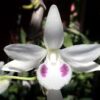# Tips for Creating the Ideal Environment for Phalaenopsis Orchids to Thrive

Phalaenopsis orchids, also known as moth orchids, are among the most popular orchids cultivated worldwide due to their stunning flowers, long-lasting blooms, and relatively easy care requirements. However, to ensure these beautiful plants flourish, it’s essential to create the ideal growing environment. This comprehensive guide will delve into various factors that contribute to the optimal growth of Phalaenopsis orchids, including light, temperature, humidity, watering, fertilization, and potting methods.
## 1. Understanding the Natural Habitat of Phalaenopsis Orchids
Before diving into specific care tips, it’s crucial to understand where Phalaenopsis orchids naturally thrive. These orchids are native to tropical regions of Southeast Asia, often growing as epiphytes on trees. In their natural habitat, they enjoy bright, filtered light, high humidity, and warm temperatures. Replicating these conditions in a home or greenhouse setting is vital for successful cultivation.
### 1.1 Natural Light Requirements
Phalaenopsis orchids prefer bright, indirect sunlight. Direct sunlight can scorch their leaves, while too little light can hinder flowering. Understanding how to provide the right light conditions is the first step toward creating an ideal environment.
### 1.2 Temperature Tolerance
These orchids thrive in warm temperatures. Ideally, they prefer daytime temperatures between 75°F to 85°F (24°C to 29°C) and nighttime temperatures around 60°F to 70°F (16°C to 21°C). Sudden temperature fluctuations can stress the plant and impact its health.
### 1.3 Humidity Levels
High humidity levels, typically between 50% and 70%, are crucial for Phalaenopsis orchids. These orchids require a moist environment to prevent leaf and root desiccation, which can lead to poor growth and flowering.
## 2. Providing the Right Light Conditions
### 2.1 Choosing the Right Location
When placing your Phalaenopsis orchids, consider the following:
– **Indoors**: Position your orchids near east or west-facing windows. These locations provide bright, indirect light for several hours a day. If the sunlight is too intense, you can use sheer curtains to diffuse the light.
– **Outdoors**: If growing outdoors, ensure the orchids are shaded from direct sunlight during the hottest parts of the day. A shaded patio or under a tree can provide the ideal light conditions.
### 2.2 Using Grow Lights
For those who lack sufficient natural light, grow lights are an excellent alternative. Full-spectrum LED grow lights can mimic natural sunlight, providing the necessary light spectrum for photosynthesis. Set the lights to remain on for 12-14 hours a day to ensure optimal growth.
### 2.3 Monitoring Light Levels
Regularly check your orchid’s leaves to assess light conditions. Healthy leaves should be a vibrant green color. If the leaves are dark green, the plant may not be receiving enough light. Conversely, yellowing leaves can indicate too much direct sunlight.
## 3. Maintaining Ideal Temperature
### 3.1 Temperature Control
Maintaining stable temperatures is essential for the health of Phalaenopsis orchids. Here are some tips for controlling temperatures:
– **Indoor Temperature**: Use thermostats to monitor indoor temperatures. During the day, keep the temperatures within the preferred range of 75°F to 85°F (24°C to 29°C). At night, the temperature can drop to around 60°F to 70°F (16°C to 21°C).
– **Airflow**: Ensure proper airflow around the plants to prevent overheating and humidity build-up. Use fans to circulate air, particularly in closed environments like greenhouses.
### 3.2 Seasonal Adjustments
As seasons change, adjust your heating or cooling methods to maintain ideal temperatures. In colder months, ensure that the heating system is functioning effectively. During warmer months, consider using air conditioning or moving orchids to cooler areas of the house.
### 3.3 Seasonal Temperature Variation
Phalaenopsis orchids benefit from slight temperature fluctuations between day and night. This variation can encourage flowering, so aim to maintain a difference of about 10°F (5°C) between daytime and nighttime temperatures.
## 4. Ensuring Adequate Humidity Levels
### 4.1 Humidity Control Methods
Maintaining high humidity levels is crucial for Phalaenopsis orchids. Here are several effective methods to achieve this:
– **Humidity Trays**: Place a shallow tray filled with pebbles and water underneath the orchid pots. As the water evaporates, it increases humidity around the plants. Ensure the pots do not sit directly in the water to prevent root rot.
– **Misting**: Lightly mist your orchids with water using a spray bottle. Misting should be done in the morning to allow leaves to dry before nightfall, preventing fungal issues.
– **Humidifiers**: Consider using a humidifier in the room where your orchids are located. This is particularly beneficial during dry winter months when indoor heating can reduce humidity levels.
### 4.2 Monitoring Humidity Levels
Use a hygrometer to measure humidity levels in the environment. This device provides accurate readings, helping you adjust humidity levels as needed to keep them between 50% and 70%.
### 4.3 Grouping Plants
Grouping several orchids together can create a microclimate with higher humidity levels. The moisture released by one plant can benefit others in close proximity, making this an effective strategy for maintaining humidity.
## 5. Watering Techniques
### 5.1 Understanding Water Requirements
Phalaenopsis orchids prefer to dry out slightly between waterings. Overwatering can lead to root rot, while underwatering can cause the plant to become dehydrated.
### 5.2 Watering Schedule
Establishing a regular watering schedule is key:
– **Frequency**: Water your orchids every 1-2 weeks, depending on the humidity and temperature levels in your environment. In warmer conditions, they may require more frequent watering.
– **Watering Method**: When watering, thoroughly soak the potting media until water drains from the bottom of the pot. This ensures that the roots receive adequate moisture.
### 5.3 Water Quality
Use distilled or rainwater for your orchids whenever possible. Tap water may contain chemicals like chlorine and fluoride, which can harm sensitive orchid roots. If using tap water, allow it to sit for 24 hours before watering to let chemicals dissipate.
### 5.4 Signs of Watering Issues
Monitor your orchids for signs of watering problems. Yellowing leaves can indicate overwatering, while shriveled leaves suggest underwatering. Adjust your watering habits accordingly to keep your orchids healthy.
## 6. Fertilization Practices
### 6.1 Choosing the Right Fertilizer
Fertilizing Phalaenopsis orchids is essential for promoting healthy growth and vibrant blooms. Use a balanced fertilizer specifically formulated for orchids, typically with an N-P-K ratio of 30-10-10 or 20-20-20.
### 6.2 Fertilization Schedule
A regular fertilization schedule helps ensure that your orchids receive the necessary nutrients:
– **Growing Season**: During the active growing season (spring and summer), fertilize your orchids every two weeks.
– **Dormant Season**: In the fall and winter months, reduce fertilization to once a month, as the plants are not actively growing.
### 6.3 Fertilizer Application
When applying fertilizer, dilute it to half the recommended strength to prevent fertilizer burn. Water your orchids first to avoid concentrating the fertilizer directly on dry roots. Apply the diluted fertilizer during watering.
### 6.4 Signs of Nutrient Deficiency
Watch for signs of nutrient deficiencies, such as slow growth, yellowing leaves, or poor flowering. Adjust your fertilization schedule or change the type of fertilizer used to address these issues.
## 7. Potting Techniques
### 7.1 Choosing the Right Potting Medium
Phalaenopsis orchids require a well-draining potting medium to prevent root rot. Common potting materials include:
– **Bark Mix**: A mix of fir bark, charcoal, and perlite provides excellent drainage and aeration for orchid roots.
– **Sphagnum Moss**: While sphagnum moss retains moisture, it should be mixed with other materials to improve drainage.
### 7.2 Repotting Schedule
Repotting Phalaenopsis orchids is essential for maintaining healthy root systems:
– **Frequency**: Repot your orchids every 1-2 years, or when the potting medium breaks down and loses its ability to retain moisture.
– **Timing**: The best time to repot is during the spring, just before the growing season begins. This allows the plant to recover from repotting before it resumes active growth.
### 7.3 Pot Selection
Choose pots with drainage holes to ensure excess water can escape. Clear plastic pots are also beneficial as they allow you to monitor root health and moisture levels.
### 7.4 Techniques for Repotting
When repotting, gently remove the orchid from its old pot, trimming any dead or rotting roots. Place the plant in the new pot, filling it with fresh potting medium. Make sure the crown of the plant is at the pot’s surface level.
## 8. Pest and Disease Management
### 8.1 Common Pests
Phalaenopsis orchids are susceptible to various pests, including:
– **Mealybugs**: These pests appear as cottony white masses on leaves and stems. Use insecticidal soap or neem oil to eliminate them.
– **Scale Insects**: Scale insects appear as small, raised bumps on leaves and stems. Treat infestations with horticultural oil or rubbing alcohol.
– **Spider Mites**: These tiny pests thrive in dry conditions and can cause leaf damage. Increase humidity and use insecticidal soap to control them
.
### 8.2 Preventive Measures
Prevent pest infestations by maintaining proper humidity levels, ensuring good air circulation, and regularly inspecting your orchids for signs of trouble.
### 8.3 Disease Prevention
Root rot and fungal infections are common issues for orchids. To prevent these problems:
– Avoid overwatering and ensure good drainage.
– Keep the foliage dry by watering in the morning.
– Use sterilized tools when cutting or repotting to prevent the spread of disease.
## 9. Conclusion
Creating an ideal environment for Phalaenopsis orchids requires attention to detail and an understanding of their natural habitat. By providing the right light, temperature, humidity, watering, fertilization, and potting techniques, you can cultivate healthy and thriving orchids that will reward you with stunning blooms year after year. Remember to monitor your orchids regularly, adjust care practices as needed, and enjoy the beauty of these magnificent plants in your home or garden. With the right care, your Phalaenopsis orchids will flourish, bringing joy and elegance to your space.

